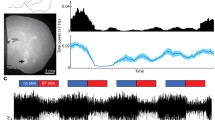Conclusions
-
1.
Decreases in the frequency and increases in the regularity of the bursts of type I–II cells of the medial septal nucleus-diagonal band nucleus (MS-DB) occur to various extents during surgical (transection of the medial forebrain bundle) and pharmacological (Nembutal) shut-offs of ascending afferentations; however, phase-frequency drives of theta cycles to a low-frequency stimulus differ substantially under these conditions.
-
2.
Nembutal sharply restricts the upper boundary for overall (up to 8 Hz) and precise (up to 5 Hz) driving of the background theta cycles to a stimulus. When basal undercutting of the septum is done, the upper boundary of overall (10 Hz) and precise (8 Hz) driving differ insignificantly from the corresponding control parameters (12 and 9 Hz).
-
3.
Nembutal significantly increases the duration of the initial pause in cells with driving “by pause” (from 55.1±2.7 to 95.2±6.7 msec). This does not occur with basal undercutting.
-
4.
Under both conditions, there is significant improvement in comparison with normal driving to low frequencies of stimulation near the background frequency of the theta cycles.
-
5.
MS-DB cells with weak rhythmic modulation (type III) can react to stimulation with two types of responses: the driving of background bursts and the following of single spikes. These responses differ with respect to latent periods, frequency optima, and pharmacological sensitivities.
Similar content being viewed by others
Literature cited
E. S. Brazhnik and O. S. Vinogradova, “Effect of complete undercutting of the septum on the activity of its neurons,” Zh. Vyssh. Nervn. Deyat.,30, No. 1, 141 (1980).
E. S. Brazhnik, O. S. Vinogradova, and A. M. Karanov, “Regulation of theta-activity of neurons of the septum by cortical and stem-diencephalic structures,” Zh. Vyssh. Nervn. Deyat.,34, No. 1, 71 (1984).
E. S. Brazhnik, “Comparative characterization of bursts of septal neurons during elimination of ascending influences of the reticular formation in rabbits (surgical and pharmacological actions),” Zh. Vyssh. Nervn. Deyat.,36, No. 4, 721 (1986).
O. S. Vinogradova and L. I. Zolotukhina, “Sensory characterization of the neurons of the medial and lateral nuclei of the septum,” Zh. Vyssh. Nervn. Deyat.,22, No. 6, 1260 (1972).
O. S. Vinogradova, S. D. Zhadina, and E. S. Brazhnik, “Analysis of the organization of background activity of septal neurons in vitro,” Neurofiziologiya,19, No. 5, 586 (1987).
A. Alonso and C. Köhler, “Evidence for separate projections of the hippocampal pyramidal and non-pyramidal neurons to different parts of the septum in the rat brain,” Neurosci. Lett.,31, No. 3, 209 (1982).
H. R. Brashear, L. Zaborsky, and L. Heimer, “Distribution of GABAergic and cholinergic neurons in the rat diagonal band,” Neuroscience,17, No. 2, 439 (1986).
E. S. Brazhnik, O. S. Vinogradova, and A. M. Karanov, “Frequency modulation of neuronal theta-burst in rabbit's septum by low frequency repetitive stimulation of the afferent bundles,” Neuroscience,14, No. 2, 501 (1985).
E. S. Brazhnik and O. S. Vinogradova, “Control of the neuronal rhythmic bursts in the septal pacemaker of the theta-rhythm: effects of anaesthetic and anticholinergic drugs,” Brain Res.,380, No. 1, 94 (1986).
J. P. Candler and K. A. Crutcher, “The septohippocampal projection in the rat: an electron-microscopic horseradish peroxidase study,” Neuroscience,10, No. 3, 685 (1983).
P. W. Gage and B. Robertson, “Prolongation of inhibitory postsynaptic currents by pentobarbitone, halothane, and ketamine in CA1 pyramidal cells in rat hippocampus,” Br. J. Pharmacol.,85, No. 3, 675 (1985).
J. M. Gaztelu and W. Buño, “Septohippocampal relationships during EEG theta-rhythm,” EEG Clin. Neurophysiol.,54, No. 4, 375 (1982).
G. Gogolak, H. Petsche, J. Sterč, and C. Stumpf, “Septum cell activity in the rabbit under reticular stimulation, Brain Res.,5, No. 3, 508 (1967).
C. Köhler and V. Chan-Palay, “Distribution of GABA-containing neurons and terminals in the septal area: an immunohistochemical study using antibodies to glutamic acid decarboxylase,” Anat. Embryol.,167, No. 1, 53 (1983).
Z. Miljkovic and J. F. MacDonald, “Voltage-dependent block of excitatory amino acid currents by pentobarbital,” Brain Res.,376, No. 2, 396 (1986).
P. Panula, A. V. Kevuelta, D. L. Cheny, et al, “An immunohistochemical study on the location of GABAergic neurons in rat septum,” J. Compar. Neurol.,222, No. 1, 69 (1984).
J. Pavlósek and M. Hricovíni, “Effects of pentobarbital on neurons in the reticular formation of the brain stem: iontophoretic study in the rat,” Gen. Physiol. Biophys.,3, No. 6, 463 (1984).
H. Petsche, C. Stumpf, and G. Gogolak, “The significance of the rabbit's septum as relay station between the raidbrain and the hippocampus,” EGG Clin. Neurophysiol.,14, No. 2, 202 (1962).
H. Petsche, G. Gogolak, and P. A. van Zwieten, “Rhythmicity of septal cell discharges at various levels of reticular excitation,” EEG Clin. Neurophysiol.,19, No. 1, 25 (1965).
S. Sawada and C. Yamamoto, “Blocking action of pentobarbital on receptors for excitatory amino acids in the guinea-pig hippocampus,” Exp. Brain Res.,59, No. 2, 226 (1985).
L. Steel and C. N. Scholfield, “GABA partly mediates the pentobarbitone depression of synaptic excitation in the guinea-pig olfactory cortex in vitro,” Neurosci. Lett.,56, No. 1, 33 (1985).
O. S. Vinogradova, E. S. Brazhnik, A. M. Karanov, and S. D. Zhadina, “Analysis of neuronal activity in rabbit's septum with various conditions of deafferentation,” Brain Res.,187, No. 2, 354 (1980).
J. F. Whitney and L. L. Glenn, “Pentobarbital and halothane hyperpolarize cat α-motor neurons,” Brain Res.,381, No. 1, 199 (1986).
E. H. F. Wong, L. M. Leeb-Lundberg, V. I. Teichberg, and R. W. Olsen, “γ-Aminobutyric acid activation of [36C1−] flux in rat hippocampal slices and its potentiation by barbituates,” Brain Res.,303, No. 2, 267 (1984).
Author information
Authors and Affiliations
Additional information
Translated from Zhurnal Vysshei Nervnoi Deyatel'nosti imeni I. P. Pavlova, Vol. 38, No. 2, pp. 323–332, March–April, 1988.
Rights and permissions
About this article
Cite this article
Brazhnik, E.S., Vinogradova, O.S. Frequency modulation of the neuronal theta bursts in the rabbit's septum deprived of ascending afferent input. Neurosci Behav Physiol 19, 26–33 (1989). https://doi.org/10.1007/BF01148407
Received:
Issue Date:
DOI: https://doi.org/10.1007/BF01148407




